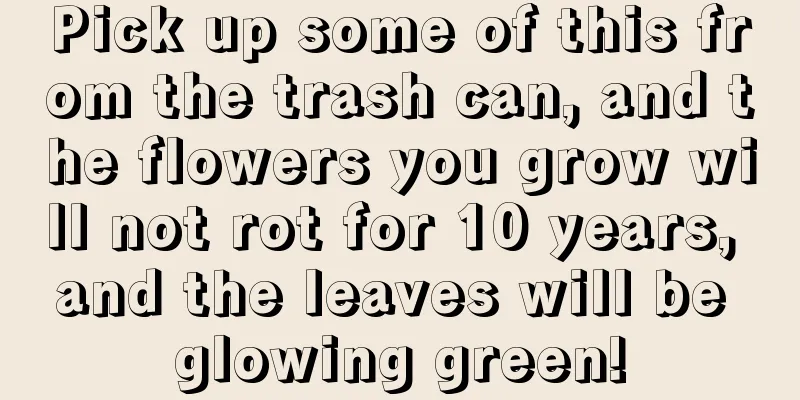Pick up some of this from the trash can, and the flowers you grow will not rot for 10 years, and the leaves will be glowing green!

Throw nut shells into the pot to prevent water accumulation and root rotFlower lovers who like to eat melon seeds and peanuts, don’t throw away the shells. Use them to grow Clivia. Without spending a penny, you can make the roots of Clivia grow thicker than your fingers, and the leaves will be wide and green! 1. Walnut shell pad the bottom of the basinWalnut shells are relatively hard. Putting them at the bottom of the Clivia pot can improve the drainage and air permeability of the soil and prevent root rot! 2. Peanut shell compostClivia likes fertilizer, and peanut shells and melon seed shells are nut shells containing oil. Crush the shells, put them into a bag, add some water, seal it and put it in the sun. It will ferment in 2 months. Then mix it into the soil and grow Clivia, it will definitely grow rapidly! 3. Spread the bowl with nut shellsThere is another easier way to use nut shells for growing flowers, which is to spread them directly on the surface of the potting soil. This can improve the soil's water retention capacity, and the nutrients in the shells can also be released into the soil. Throw sawdust into the soil, and the flowers will bloomIf there are flower lovers who are decorating their new home or there is a sawmill around their home, be sure to get some sawdust to grow flowers. The flowers will grow rapidly like they were injected with chicken blood! 1. Sawdust and water fermentationPour an appropriate amount of clean water into the sawdust, then put it into a plastic bucket. Seal and ferment for 2 months, then take it out and mix it into the soil. This will make the soil looser and the roots grow faster! 2. After boiling with boiling water, fermentation is fasterFor flower lovers who are anxious to use sawdust to grow flowers, you can first boil the sawdust in a pot, let it cool down after boiling, and then put it into a barrel and seal it for fermentation. This can shorten the fermentation time. 3. Sawdust germinationSawdust has good water retention and can be used to promote germination. For example, it can increase the germination rate of Clivia seeds. Throw pine needles into the pot, and the flower roots will be thick and strongWhen flower lovers go on picnics in the wild, if they come across a pine tree, they can pick up some pine needles under the tree to grow flowers. This will make the soil loose and breathable, and the roots will never rot again! 1. Fermented pine needles can be used directlyGenerally speaking, the pine needles covering the bottom of old pine trees are fermented. You can pick some and use them directly when you bring them home. 2. Sterilize before useThere are many germs and parasites in the wild pine needles. If you use them directly to grow flowers, the flowers will be infected by the germs. Therefore, they must be disinfected. You can sterilize them by pouring boiling water through them, or you can soak them in a solution of carbendazim. These garbage, Have you ever used it to grow flowers? No cost, Just let the flowers grow! Share it with other flower lovers quickly! |
<<: There are 3 methods of rose cuttings. Learn one and you will get 100% success!
Recommend
Varieties of Hydrangea
Alpengluhin This is a very common variety, and th...
Tips for dividing the Jade Lotus
Season Selection The division of Te Yu Lian is us...
When does the blue flower bloom?
When does the blue flower bloom? I believe the be...
What are the special fertilizers for citrus?
Fertilization of citrus is very important. Fertil...
Cultivation methods and precautions of umbrella grass
1. Maintenance methods 1. Soil: During its growth...
Common pests of Monstera and their control methods
Common pests of Monstera include citrus mealybugs...
Why don't orchids smell good?
Reason 1: Insufficient light Orchids prefer a sem...
How to grow moss
Moss growth conditions Moss cannot grow in places...
How to grow roses in spring
1. Suitable temperature It likes warmth, so the t...
Why are the leaves of the four-season plum turning yellow?
1. The culture soil is alkaline 1. Specific reaso...
What to do if the leaves of the fortune tree droop
The leaves droop because of water loss. Overwater...
Where is the best place to grow Hericium erinaceus?
Hericium erinaceus cultivation conditions Hericiu...
When is the best time to sow violets?
Suitable time for sowing violets Violets belong t...
Can fish scales be used as fertilizer?
Fish scales as fertilizer Fish scales can be used...
How long does it take for dragon fruit cuttings to take root?
Dragon fruit cutting rooting time Dragon fruit ca...









